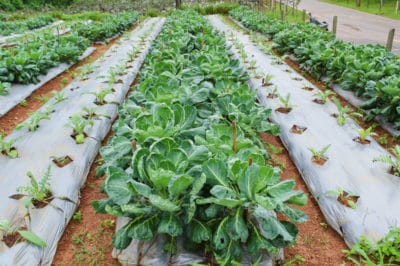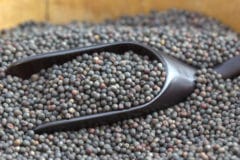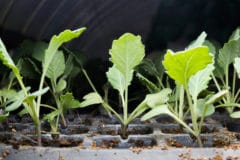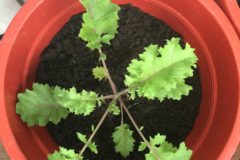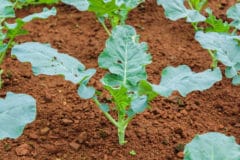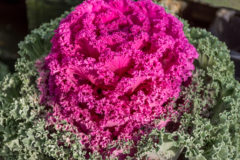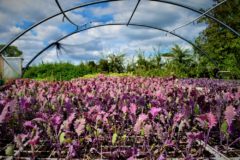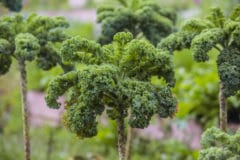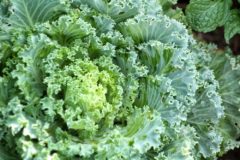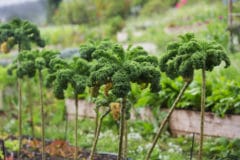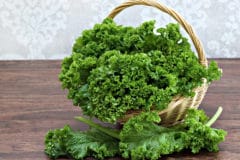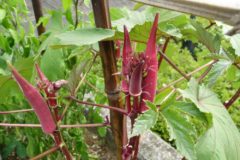Meta Description: Kale survives temperatures to 20°F (-7°C), making it the last veggie standing in your garden. Read here to learn how to grow this sweet, hardy salad green.
Kale provides greens for garden fresh salads at temperatures down to 20°F (-7°C). Kale even tastes sweeter after a frost that turns it’s carbohydrates to sugar. For sweet salad greens year round, you can even grow kale indoors.
Where Should I Plant Kale?
Kale is a hardy plant, but it does have light, temperature, soil, and moisture preferences that will influence where you plant it. Read on to learn more about how to grow kale in your garden.
What Temperatures Are Best for Growing Kale?
For kale seeds to germinate, the soil temperature needs to be at least 40°F (4°C), but 70°F (21°C) is ideal.
Temperatures above 80°F (27°C) cause kale to become tough and bitter. If that occurs, try massaging the leaves to restore a sweeter taste. Yes, really. Massage them. Try it.
What Type of Lighting Does Kale Prefer?
Kale prefers full to partial sun most of the time. In the spring, it’s a good idea to
plant your kale in a spot that receives full sun to provide warmth. If you want to harvest kale in the heat of summer, though, pick a cooler spot with some shade.
What Type of Soil Does Kale Prefer?
Kale grows best in loamy (sandy) soil. Test the pH balance of your soil before planting. Kale prefers a pH between 5.5 and 6.8. A lower number means that your soil may be too acidic for kale. Add wood ash to reduce the acidity.
How Much Moisture Does Kale Need?
Plant your kale in an area that drains well but that retains some moisture beneath the surface. Avoid planting kale in areas where water creates puddles or where the soil remains wet.
What Companion Plants Should I Plant With Kale?
Keep your kale happy by planting it near plants such as:
- Beets
- Celery
- Onions
- Potatoes
Planting kale in or next to your herb garden is another good choice.
What Other Plants Benefit Kale?
Companion plants that repel kale’s insect pests or lure them elsewhere include:
- Thyme – It repels the imported cabbage worm.
- Members of the mustard family, such as bittercress – Scientific studies show that bittercress, also known as rocket cress, attracts the diamondback moth and the imported cabbage white moth but contains a substance that causes the caterpillars to die.
- Catnip and basil — Both repel flea beetles.
- Nasturtiums and radishes – These plants lure flea beetles away from kale.
Are There Plants That Should Be Separated From Kale?
Kale does not get along well with plants such as:
- Beans
- Strawberries
- Tomatoes
When Should I Plant Kale?
If you plan on growing your own seedlings to transplant into your garden, the usual advice is to start the seeds five to seven weeks before the last frost date and to transplant the seedlings one to two weeks before the last frost date.
If you are planting kale seeds outdoors, sow them two to four weeks before your last frost date.
Check with your local extension service if you are uncertain about the last frost date for your area.
What Should I Do Before I Plant?
Test the soil to learn what nutrients it may need. You can cover the area that you’ve chosen for your kale with compost or organic fertilizer, and then work it into the soil. You should be able to plant the next day if you use a compost that already has been aged, but if you need to treat your soil with a strong organic fertilizer, you should apply it a week or two before you intend to plant your kale.
Using mulch as a fertilizer saves time and effort because you don’t need to work it into the soil. Just place it around your plants.
How Do I Start Seedlings From Seeds Indoors?
You can plant your seeds in a mixture of soil and compost or veganic fertilizer using small pots, but if you plant them in toilet paper rolls, you will have a ready-made cardboard collar to protect your seedlings from cutworms. Just transplant the seedlings collar and all.
Cover your seeds with ½ inch of soil. Keep the soil evenly moist, but allow the very top layer to dry between each watering to prevent the soil from becoming overly moist.
The first pairs of leaves to sprout will be the cotyledons. These are not true leaves but part of the seed. They provide nourishment to the seedlings until the true leaves form, and then they wither and drop off. Wait to transplant your seedlings until they are at least 3-4 inches tall and have at least four true leaves with two more true leaves forming.
How To I Plant Seeds Outdoors?
Space the seeds 3 inches apart in rows that are 18-24 inches apart, and then thin them to 12-15 inches apart when they are 3-4 inches tall and have at least four true leaves. You can move the plants you thin to a partly shaded area for summer harvesting or use the leaves as seasoning when you cook.
How To I Transplant My Seedlings?
Plant your seedlings 12-15 inches apart in rows that are 18-24 inches apart. Place the plants so that the stems form a right angle to the ground. Don’t cover the first set of leaves, but make sure that the soil supports the stem.
How Much Kale Should I Plant?
You should have three to four plants for each person in your family, plus more for guests. Keep in mind that some of your plants may not survive, so always plant extra.
How Do I Care for My Kale?
Kale needs the most care from the time you transplant it until your plants are established. Once it is established, kale has few problems with pests or diseases.
- Keep the soil moist, but don’t overwater.
- Place compost around the plants every six to eight weeks.
- Pick the worm-like green caterpillars from your kale by hand.
- Look for cutworms in the evening or on cloudy days, and remove them while wearing gloves.
- Row covers keep most insects from coming anywhere near your kale.
- Use companion plants to discourage insect pests from approaching your kale and to encourage them to move to other areas.
How Do I Avoid Kale’s Pests?
If you have brushy or weedy areas near your garden or you didn’t till your garden in the fall, you could have a problem with some of kale’s insect pests. These caterpillars and insects emerge as the temperatures warm. So, delaying planting your kale until the later of the dates above may send them looking elsewhere for their spring breakfast.
What Diseases Can Affect Kale?
Kale, cabbage, broccoli, and collards are all related, and they are all susceptible to the same. diseases. These diseases include:
- Bacterial leaf spots
- Black rot
- Fungal leaf diseases
- Root-knot
The same steps protect all four of these plants from all four diseases.
In the fall, clear your garden of all vegetation, or use it as “green manure” and work it into the soil as compost. Working compost into the soil in the fall will help your garden manage water and drainage better in the spring. Wet soil that doesn’t drain well allows the fungi that cause some of these diseases to grow.
Planting these four vegetables in the same place in your garden year after year also encourages these diseases. Crop rotation deters the problem. So, rotate the spaces where you have been planting your kale, collards, broccoli, and cabbage with plants from unrelated families.
Getting the leaves of these plants wet when you water your garden also promotes fungal growth. Using soaker hoses eliminates the problem.
Generally, kale is very hardy. When it is planted in soil that drains well, and when crops are rotated each year, kale rarely is attacked by diseases.
When Can I Start Using My Kale?
Your kale is ready to eat when the leaves reach the size of your hand. Pick the leaves from the ground up, and always leave least four leaves at the top so that your kale continues to produce.
What Do I Do if I Pick More Than I Need?
You can store kale leaves in a plastic bag in your refrigerator for a few days just as you can store lettuce or cabbage.
How Long Will My Kale Keep Producing?
Kale will keep producing as long as the temperature remains above 20°F (-7°C), and it will taste even sweeter after the first frost.
